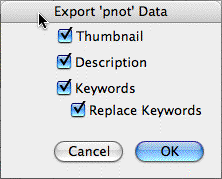
Manual: p128-129 (v6), p190 (v5)
Note: v7 drops support for pnot data. This is not unexpected as OS X has now moved to a Unix style file system with the HFS resource forks maintained for legacy purposes. However, mainstream aplications are moving away from use of such feature, so Portfolio's move is not out of step.
Apple's 'pnot' data is a little-documented part of the QuickTime infrastructure. The Macintosh version of Portfolio allows you to embed the keywords and descriptions you create in Portfolio directly into your original image files. Portfolio places this embedded data in the pnot resource within each file (in the file's resource fork), so that the information can be accessed using any Mac program that can open and read pnot data, such as Photoshop. Once you've exported pnot data, you can view keywords and descriptions for your original images within Photoshop itself using Photoshop's File Info command.
Key points to note are:
Procedure to export pnot data to your original files:

Using exported pnot data in a cross-platform environment:
Although Photoshop (and other pnot compatible programs) will show the exported pnot info in its 'File Info' dialog this data is external to the file. To persist the information and to make it available to users on Windows, you need to save the file. However, the pnot is a dynamic resource - in short, the program looks for pnot data and if more recent than the files stored data uses this in preference; as such the file itself is unchanged, despite the new data. Therefore you must use a 'save as' command instead of 'save' (which is most likely greyed out). A full 'save as' will cause the new pnot info to be added to the data stored in the file.
Using pnot on newer systems:
New/updated Mac applications, especially on OSX, are moving away from using the resource fork. Although the fork still exists, programs are moving to the Windows/Unix style of having one file for all the information. Therefore, pnot data use as described above has to be viewed as a 'legacy' method which is liable to be broken as Portfolio, Photoshop, etc., and the OS itself evolve.
Question: Using 'pnot' data (Mac) [FAQ00003.htm]
Last Update:- 02 June 2006
Site and articles © Mark Anderson 2001-2007 - Visit my home page
